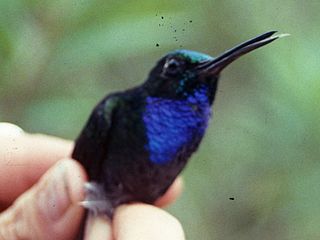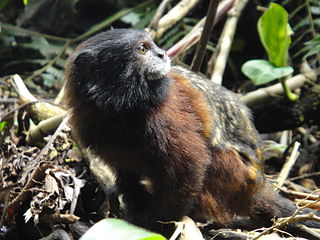
The Lucifer titi monkey is a species of titi, a type of New World monkey, from South America. It is found in Brazil, Colombia, Ecuador, and Peru. It was described as Callicebus lucifer in 1914. The Lucifer titi has previously been treated as part of C. torquatus, the collared titi.

The silky short-tailed bat is a bat species found in Bolivia, Brazil, Colombia, Ecuador, French Guiana, Guyana, Panama, Peru, Suriname, Mexico and Venezuela.

The Napo spiny rat is a spiny rat species found in Brazil, Colombia, Ecuador, Peru and Venezuela.

The black tinamou is a species of ground bird found in humid foothill and montane forest in the Andes of South America.

The Napo sabrewing is a Near Threatened species of hummingbird in the "emeralds", tribe Trochilini of subfamily Trochilinae. It is found in Colombia, Ecuador, and Peru.

Osornophryne antisana, the Napo plump toad, is a species of toad in the family Bufonidae. It is endemic to Ecuador. Its natural habitats are subtropical or tropical moist montane forests, subtropical or tropical high-altitude shrubland, and subtropical or tropical high-altitude grassland. It is threatened by habitat loss.

Osornophryne sumacoensis is a species of toad in the family Bufonidae. It is endemic to the Ecuador and only found in the forests surrounding a small crater lake on the eastern slopes of Sumaco, a volcano in the Napo Province.
Microcaecilia albiceps is a species of caecilian in the family Siphonopidae. It is found in the Amazonian lowlands and slopes of the eastern Andes in Colombia and Ecuador, possibly extending into Loreto in Amazonian Peru.

Nymphargus anomalus is a species of frog in the family Centrolenidae. It is endemic to Ecuador and occurs on the Amazonian slopes of the Ecuadorian Andes in the Napo Province. Common name Napo Cochran frog has been coined for it.
Osteocephalus fuscifacies is a species of frog in the family Hylidae endemic to Ecuador. It is known from the Napo River drainage at intermediate elevations. The specific name fuscifacies is derived from Latin fuscus (=tan) and facies (=face), in reference to the uniform tan-colored loreal region and the lack of a light subocular spot. Common name Napo slender-legged treefrog has been coined for this species.
Sphaenorhynchus carneus, the Napo lime treefrog, is a species of frog in the family Hylidae. It is found in the upper Amazon Basin in southern Colombia, Ecuador, Peru and in central Amazonia in Brazil. It might also occur in Bolivia.
Pristimantis ernesti is a species of frog in the family Strabomantidae. It is endemic to the summit of Sumaco, a volcano in the Napo Province, Ecuador. Its common name is Ernest's robber frog. It is named after Dr. Ernst Williams, a friend and colleague of the scientist that described the species. It is a little studied species.
Goeppertia gandersii is a species of flowering plant in the Marantaceae family. It is endemic to Napo Province of Ecuador. Its natural habitats are subtropical or tropical moist lowland forests and subtropical or tropical moist montane forests.
Licania hedbergii is a species of plant in the family Chrysobalanaceae. It is endemic to Ecuador. Its natural habitat is subtropical or tropical moist montane forests.
Pilea schimpfii is a species of plant in the family Urticaceae. It is endemic to the Chimborazo, Napo, El Oro, and Carchi provinces of Ecuador. Its natural habitats are subtropical or tropical moist lowland forests and subtropical or tropical moist montane forests. During the second world war, the only plants in captivity were destroyed in the German herbarium in Berlin, Germany.

Sumaco Napo-Galeras National Park is a protected area in Ecuador situated in the Napo Province, Orellana Province and Sucumbíos Province. The highest point of the park is the Sumaco volcano that peaks at 3,732 m; the lowest altitude is 600 m.

Pristimantis acerus is a species of frog in the family Strabomantidae. It is endemic to Ecuador and known from the area of its type locality between Papallacta and Cuyujúathe in the Napo Province and from the Llanganates National Park, Pastaza Province. This species is rated as Endangered by the IUCN. Common name Papallacta robber frog has been coined for it.

The Napo saki, also known as the Napo monk saki, is a species of saki monkey, a type of New World monkey. Its range includes parts of eastern Ecuador and northern Peru. The name is derived from the Napo River in its locality. This species was originally described by Lönnberg as the subspecies Pithecia monachus napensis and has been treated as a synonym of P. monachus monachus. Hershkovitz retained it under P. monachus in 1987, but it was raised to full species status in 2014.

The red-mantled saddle-back tamarin is a species of saddle-back tamarin, a type of small monkey from South America. The red-mantled saddle-back tamarin was formerly considered to be a subspecies of the brown-mantled tamarin, L. fuscicollis. It lives in Ecuador and Peru and its type locality is in Peru, near the confluence of the Amazon River and the Napo River.

The hairy saki is a species of saki monkey, a type of New World monkey. It is found in northern Peru, southern Colombia, and a small portion of northwestern Brazil.













